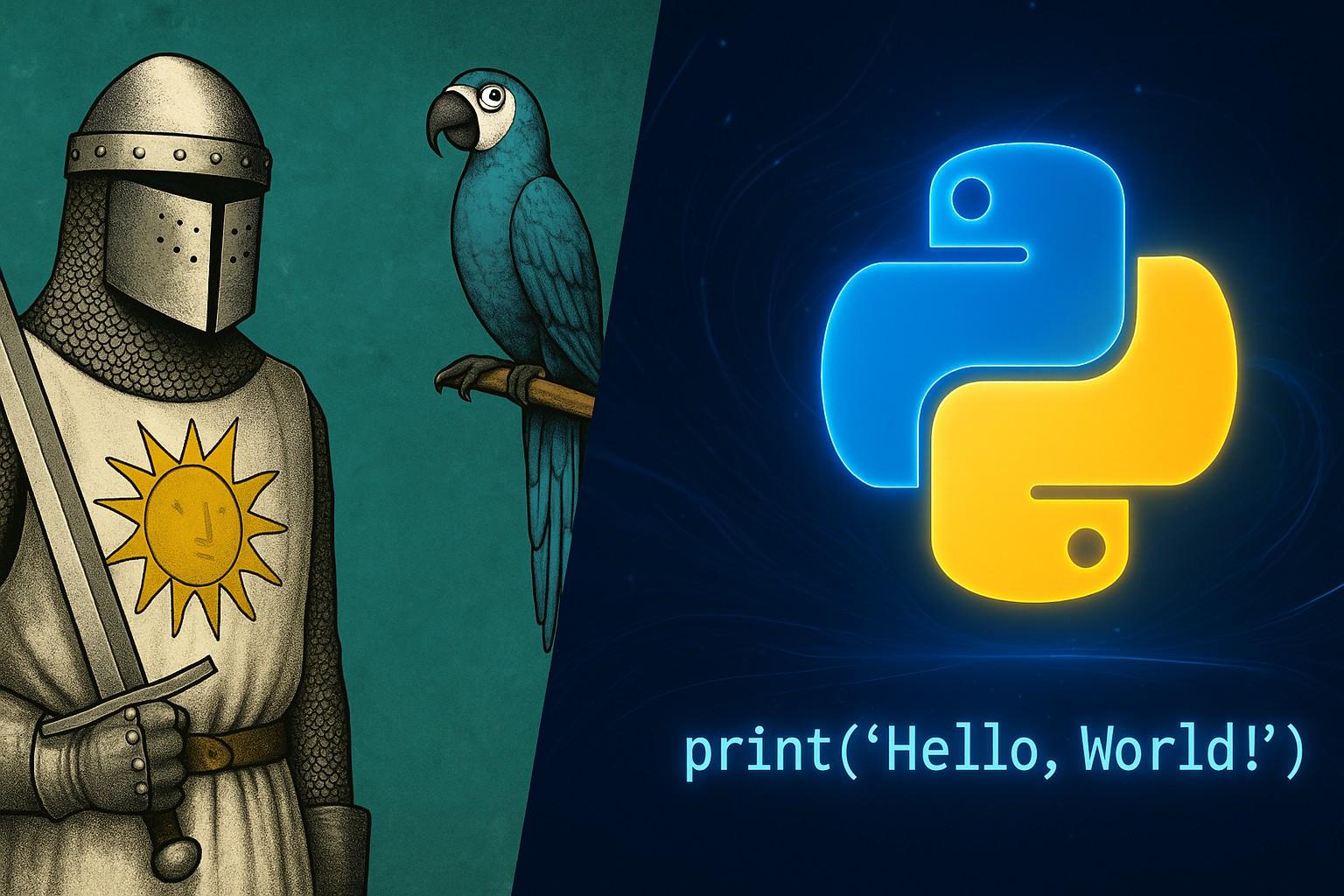The Python programming language is not actually named after the snake, despite what many people assume. The origin of the name “Python” comes from a completely different source — a British comedy group called Monty Python. The creator of the Python language, Guido van Rossum, named it after Monty Python’s Flying Circus, a surreal sketch comedy show that aired on the BBC in the late 1960s and 1970s. However, due to the association with the word “python” as a type of snake, many mistakenly believe that the language’s name is reptile-inspired. This confusion has only deepened over time, with snake-related logos and graphics being used frequently in Python branding. This essay explores the real origin of Python’s name, why this myth of the snake persists, and how the quirky origins reflect the design philosophy of the language itself.
The True Origin: Monty Python
In the late 1980s, Guido van Rossum, a Dutch computer programmer, was working on a project to create a new scripting language that would be easy to read, simple to write, and powerful enough for various kinds of software development. At the time, he was also a fan of British humor, especially the comedy show Monty Python’s Flying Circus. While working on his new language during the Christmas holidays in 1989, he wanted a name that was short, unique, and slightly mysterious. “Python” seemed like the perfect choice — it was distinctive, easy to type, and paid homage to the Monty Python show he enjoyed.
Guido has explicitly said that the name had nothing to do with snakes. In fact, the decision was made mostly on a whim, and he was simply looking for something catchy and unconventional. The result was “Python”, named after Monty Python, not the animal.
Why the Snake Confusion Exists
Despite its comedic roots, many people assume the language is named after the python snake, which is understandable. The word “python” is widely known as the name of a large constrictor snake found in Africa and Asia. When people hear “Python programming”, their brains often default to the animal because it is the more common cultural reference. This misunderstanding is further reinforced by several factors:
- Logo Design: The official Python logo features two snakes, coiled in a way that resembles the letters “P” and “y”. This was likely done as a visual pun or branding tactic, but it has misled many into thinking the snake was the inspiration for the name.
- Mascots and Icons: A number of Python-related tutorials, software, or communities use snake imagery, either as a literal python snake or cartoon versions of it. These visuals further deepen the false association.
- Language Puns: Many educational resources or community events embrace the snake theme, using names like “PyCon” (Python Conference), “Pyladies”, or “PySnake” as puns. These help branding and memorability, but contribute to the snake confusion.
- Nature of Programming Language Names: Many programming languages have names based on animals (e.g., Perl, named after “pearl”; Ruby, named after the gemstone; and Cobra, actually named after the snake). Given this trend, it’s not surprising that many assume Python follows the same pattern.
Python’s Naming Philosophy and Design Principles
The whimsical nature of the name “Python” reflects deeper truths about the language’s design philosophy. Python was intended to be fun to use, just as Monty Python’s comedy was fun to watch. This sense of humor and simplicity influenced many aspects of the language:
- Readability: Python code is meant to be readable, almost like plain English. This is in contrast to more cryptic programming languages like C or Perl.
- Less Boilerplate: Python reduces unnecessary code. It follows the principle of “There should be one—and preferably only one—obvious way to do it,” from the Zen of Python (a collection of guiding principles for writing Python code).
- Rapid Development: Python allows developers to write software quickly, just as Monty Python sketches often jumped directly into the humor without lengthy setups.
- Community Culture: The Python community embraces the fun, creative spirit. Many documentation examples and tutorials include humorous or quirky references, sometimes even drawing on Monty Python scripts like “Spam, spam, spam…” or the “Dead Parrot” sketch.
This unique blend of practicality and playfulness is part of why Python has become one of the most beloved and widely used programming languages in the world today.
The Role of Myth in Technology
The misunderstanding around Python’s name is not just a quirk — it reflects a broader phenomenon in technology. Many tools, languages, and platforms have mythologies or legends surrounding them that persist even when they’re not accurate. This happens because:
- People like stories: A story about a language named after a powerful snake is easy to visualize and share.
- Symbols matter: The snake is a compelling, dynamic image. It communicates power, agility, and flexibility — qualities Python programmers may want to identify with.
- The truth is often boring: “It was named after a British comedy show” doesn’t sound as dramatic as “It was named after a powerful jungle predator.”
So while the truth may be well-known in programming circles, the myth often survives because it fits so well with the aesthetics and imagination of learners and developers.
Embracing the Dual Meaning
Interestingly, the Python community has embraced both meanings — the true one (Monty Python) and the myth (the snake). For example:
- The PyPI logo (Python Package Index) uses playful snake-like typography.
- The community includes plenty of snake-themed puns, memes, and mascots.
- Tutorials may refer to “slithering into Python,” playing off the snake image for humor or clarity.
This duality shows the flexibility and openness of the Python community — a trait that mirrors the flexibility of the language itself. Python is used in everything from web development and automation to data science, artificial intelligence, and education. Whether someone is a fan of British humor or a fan of snakes, they’ll find Python appealing.
Conclusion
The Python programming language was not named after the python snake, but rather after Monty Python, the British comedy troupe. Guido van Rossum’s choice of name was influenced by a desire for something short, unique, and slightly mysterious. Over time, however, the more common association with the snake took hold in the public imagination, reinforced by logos, icons, and cultural metaphors.
Despite the confusion, this dual identity has not harmed the language—in fact, it may have helped. The name “Python” remains memorable and iconic, and the snake imagery provides a rich source of branding and creativity. In the end, whether you think of Monty Python or a giant reptile, the important thing is that Python remains one of the most readable, accessible, and powerful programming languages ever created.
– Dr. Preenon Bagchi, Dean
Faculty of Engineering and Technology, Madhav University

